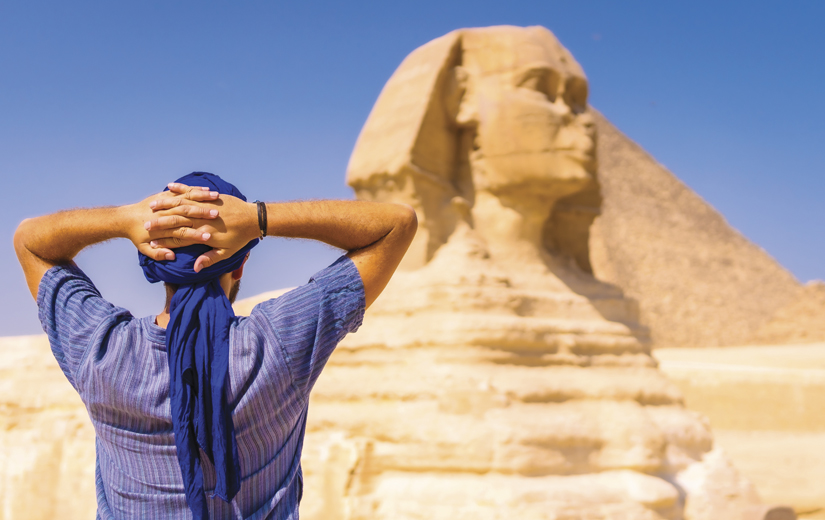Cairo is the dream destination of every traveller
BY SHAFQUAT ALI
It was an Arabian night to remember as the Pyramids of Giza changed colours, dazzled and mesmerised during the son et lumiere show. The oldest of the seven ancient wonders, they had me in a bind.
The son et lumiere show went on to highlight the history of the pyramids and that of the Sphinx. The melodrama of multiculoured lasers and portentous, Burtonian narration – of the “All men fear time but time fears the Sphinx” variety – was captivating but it was the faces of the pyramids and Sphinx that kept coming back to haunt me again and again long after the show was over.
I returned to the comfort of my hotel room with a splendid view of the Nile and the Cairo skyline sparkling in the night. However, nothing could compare with what I had just witnessed. No matter how many postcards you’ve seen, I bet nothing prepares you for the real thing!
Not surprisingly, I wound my way back to Giza the following day again. This time, with the sun beating down my head, I trotted on a camel and after passing the Great Pyramid of Cheops, the oldest on the site and the largest in Egypt, reached the entrance of the smallest of the three pyramids, Menkaure, just in time before it closed its door.
Crouched nearly on all fours, I climbed down the long, steep stairways and down tiny passages to the empty burial chambers but tired and exhausted, I ran up the same route double quick as I could hardly bear the heat, the airlessness and the claustrophobia.
Gasping for breath, I rushed out and, ignoring calls from my chirpy guide – “Oh, mister, now you want to see Sphinxter?” – I headed straight back to civilisation.
I know there are other pyramids to see in Egypt as well – including those in nearby Sakkara – but if you’ve seen the big one, you’ve seen them all.
Next, it was important to see what lay beneath the pyramids. So, off I went to the gargantuan Egyptian Museum of Antiquities. Representing the largest collection of its kind in the world, it boasts more than 100,000 artefacts spanning Egyptian history from the earliest dynasties to the Roman era.
It will take more than a day – may be an entire week – to see every exhibit but among the must-see attractions here are the Tutankhamen Galleries, which display the gold and gem-inlaid funerary mask and 1,700 other treasures found in the tomb of the Boy King, and the Royal Mummy Room, which contains the corpses of 11 of Egypt’s most powerful pharaohs including Seti I and his son Ramses II.
The figures still have somewhat distinct features and as one stares into the face of kings and queens who died some 3,000 years ago it’s difficult not to get goose pimples.
Cairo may not be the most beautiful city in the world – in fact, it is dirty and overpopulated – but it’s charm stems from the fact that it is a product of its history, a history that also lives on in the streets of the ‘city of the thousand minarets’.
The unique thing about Cairo is that each new ruler – whether Roman, Greek, Persian, French or Arabs – rather than destroying what he had conquered, chose to build a new city upwind from the old. Not surprising then that you have distinctly different parts of the city i.e. Old Cairo, Islamic Cairo, the colonial downtown, the urban suburb of Heliopolis and, of course, Giza, home to the famous pyramids. However, it is, perhaps, the Old City, with its maze-like shopping district and ancient mosques that is the most enchanting part of Cairo.
Here, more than anywhere else in Egypt, you will be transported to the Middle Ages, especially as you walk through the Khan El-Khalili, the central shopping bazaar which has remained largely unchanged since the 14th century.
From polyester bellydancing costumes to souvenirs to essential oils to hieroglyphed papyri, you name it and an Egyptian salesman in pale blue galabeyya will offer it. But more than shopping, with winding medieval alleys and more, Khan El-Khalili is a complete experience with teeming roadside food stalls, grand ancient mosques and traditional Egyptian music rending the air.
Clearly, there’s more to city than pyramids and pharaohs – and bellydancing and Nile cruises thrown in for good measure. The minarets may be crumbling, the people may be struggling to make ends meet and the city itself may be in dire need of a facelift but despite all else, wherever you go, there’s a certain life to Cairo that is uniquely its own.


